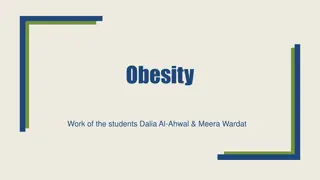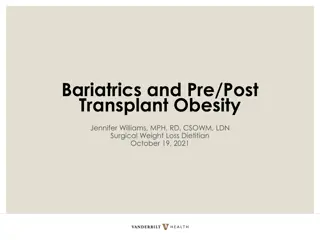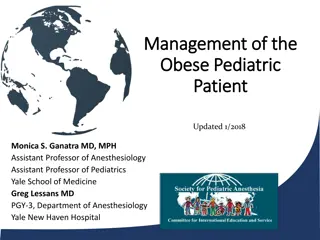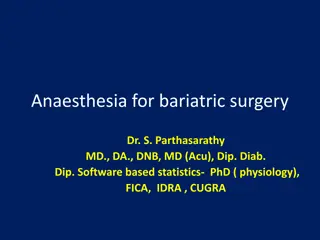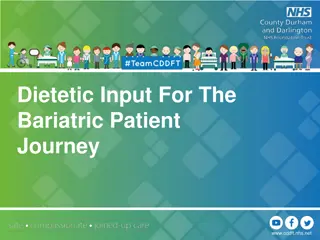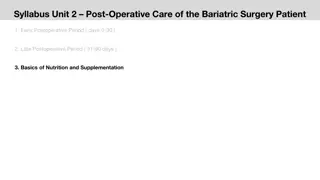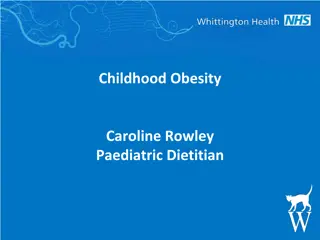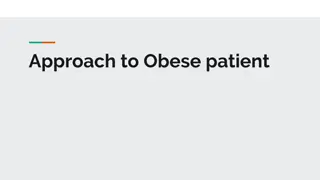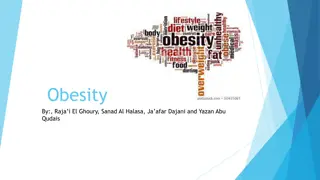Benefits of Bariatric Surgery for Obesity Patients
Bariatric surgery is a highly effective treatment for obesity, offering significant improvements in comorbidities such as diabetes, hyperlipidemia, and hypertension. Studies show that the surgery resolves conditions like obstructive sleep apnea and gastroesophageal reflux, leading to improved quality of life and reduced mortality rates in patients. Long-term research indicates positive outcomes in terms of weight loss and overall health benefits for individuals with severe obesity.
Download Presentation

Please find below an Image/Link to download the presentation.
The content on the website is provided AS IS for your information and personal use only. It may not be sold, licensed, or shared on other websites without obtaining consent from the author.If you encounter any issues during the download, it is possible that the publisher has removed the file from their server.
You are allowed to download the files provided on this website for personal or commercial use, subject to the condition that they are used lawfully. All files are the property of their respective owners.
The content on the website is provided AS IS for your information and personal use only. It may not be sold, licensed, or shared on other websites without obtaining consent from the author.
E N D
Presentation Transcript
Bariatric surgery KHALAJ A.R. M.D Obesity Clinic Mostafa Khomini Hospital Shahed University Tehran WWW.IRANOBESITY.COM
Why Surgery ? What is Indication of Surgery? What is ContraIndication of surgery? What is benefit of laparoscopy verses open surgery ? Which procedure is better for your patient ? What is Complication of obesity surgery ?
Reduction of comorbidities Reduction in mortality Surgery compared to medical treatment Treatment for type 2 diabetes
Meta-analysis: surgical treatment of obesity. Ann Intern Med 2005 Apr 5;142(7):547-59. Maggard MA; et al 147 studies Bariatric surgery: a systematic review and meta-analysis. AU Buchwald H; Avidor Y; Braunwald E; Jensen MD; Pories W; Fahrbach K; Schoelles K SO JAMA 2004 Oct 13;292(14):1724-37 136 fully extracted studies,
Diabetes completely resolved in 77 percent and resolved or improved in 86 percent. Hyperlipidemia improved in 70 percent or more of patients. Hypertension resolved in 62 percent and resolved or improved in 79 percent.
Obstructive sleep apnea resolved in 86 percent and resolved or improved in 84 percent. Gastroesophageal reflux symptoms improve and complete or partial regression of Barrett's esophagus has been demonstrated.
Long-term mortality after gastric bypass surgery. Adams TD; et al N Engl J Med. 2007 Aug 23;357(8):753-61. cohort study from 1984 to 2002 9949 patients who had undergone gastric bypass surgery 9628 severely obese in control group
Effects of bariatric surgery on mortality in Swedish obese subjects. AU Sjostrom L; Narbro K; Sjostrom CD; Karason K; Larsson B; Wedel H; Lystig T; Sullivan M; Bouchard C; Carlsson B; Bengtsson C; Dahlgren S; Gummesson A; Jacobson P; Karlsson J; Lindroos AK; Lonroth H; Naslund I; Olbers T; Stenlof K; Torgerson J; Agren G; Carlsson LM SO N Engl J Med. 2007 Aug 23;357(8):741-52.
. Deaths from all causes were reduced by 40 percent, from diabetes by 92 percent, from coronary disease by 56 percent, and from cancers by 60 percent. Although the majority of mortality data for bariatric surgery comes from patients under age 65, a retrospective cohort analysis suggests that survival is improved, even in patients over age 65
CONCLUSIONS: Bariatric surgery for severe obesity is associated with long-term weight loss and decreased overall mortality.
The Swedish Obese Subjects (SOS) study-- rationale and results. Swedish obese subjects (SOS)--an intervention study of obesity. Two-year follow-up of health-related quality of life (HRQL) and eating behavior after gastric surgery for severe obesity. Effects of bariatric surgery on mortality in Swedish obese subjects.
Weight decreased by 23 percent after two years in the surgery group while it increased in the control group by 0.1 percent [35]. After 10 years, weight had decreased by 16 percent in the surgery group and increased in the control group by 1.6 percent The surgery group had better two and 10- year incidence rates of diabetes, hypertriglyceridemia, lowered HDL levels, improved hypertension and hyperuricemia rates.
Surgically treated patients were significantly less likely to require medications for cardiovascular disease or diabetes at two and six years Surgically treated patients had dramatic improvement in scores on validated measures of quality of life and psychiatric dysfunction
After 10 years of follow-up, the improvements in quality of life diminished somewhat in the surgery group due to weight regain, but overall outcome was still significantly better in the surgical than the medically treated group
Adjustable gastric banding and conventional therapy for type 2 diabetes: a randomized controlled trial. Improvement in glucose metabolism after bariatric surgery: comparison of laparoscopic Roux-en-Y gastric bypass and laparoscopic sleeve gastrectomy: a prospective randomized trial. Cost-efficacy of surgically induced weight loss for the management of type 2 diabetes: a randomized controlled trial.
Participants randomized to surgical therapy were more likely to achieve remission of type 2 diabetes through greater weight loss. Both procedures markedly improved glucose homeostasis. Surgical therapy appears to be a cost- effective option for managing type 2 diabetes in class I and II obese patients.
Be well-informed and motivated Have a BMI >40 Have acceptable risk for surgery Have failed previous non-surgical weight loss The NIH also suggested that adults with a BMI >35 who have serious comorbidities such as diabetes, sleep apnea, obesity-related cardiomyopathy, or severe joint disease may also be candidates
untreated major depression or psychosis, binge eating disorders, current drug and alcohol abuse, severe cardiac disease with prohibitive anesthetic risks severe coagulopathy inability to comply with nutritional requirements including life-long vitamin replacement Bariatric surgery in advanced (above 65) or very young age (under 18) is controversial.
Wound infection Rates of wound infection are significantly greater with open (10 to 15 percent) than laparoscopic (3 to 4 percent) gastric bypass procedures . SO - Ann Surg 2000 Oct;232(4):515-29 Ventral incisional hernia Ventral incisional hernias occur with a frequency of 0 to 1.8 percent in laparoscopic series and as high as 24 percent in open series, underscoring a clear advantage of the laparoscopic approach in this regard SO - Ann Surg 2001 Sep;234(3):279-89; discussion 289-91 Reduction in postoperative pain, shorter length of hospital stay, and faster recovery
Postoperative Pulmonary Function FEV higher on the first postoperative day after laparoscopic than after open GBP lower rate of segmental atelectasis after laparoscopic GBP Nguyen NT, Lee SL, Goldman C, et al.: Comparison of pulmonary function and postoperative pain after laparoscopic versus open gastric bypass: A randomized trial. J Am Coll Surg 192:469 476, 2001. Postoperative Pulmonary Function FEV1 1 was 38%
Postoperative Pain Despite utilizing greater dosages of narcotics, open GBP patients still reported higher visual analog pain score Weight Loss 6 Long term L=O Ann Surg 239:433 437, 2004 Obes Surg 13:341 346, 2003. Obes Surg 10:233 239, 2000 Postoperative Pain Weight Loss 6 months after surgery L>O Long term L=O months after surgery L>O
Mastering the technique of laparoscopic GBP often requires between 75 and 100 cases.
Patients dietary and psychology history Medical and surgical history Surgeon experience Patient comfort and expectation Ability of medical facility to handle most known complications
There is no gold standard operation . A surgeon should be able to perform more than one operation. Patient can be matched to a specific procedure
Restrictive Vertical banded gastroplasty Laparoscopic adjustable gastric band Sleeve gastrectomy Malabsorptive Jejunoileal bypass Biliopancreatic diversion Biliopancreatic diversion with duodenal switch Combination of restrictive and Roux-en-Y gastric bypass Restrictive Malabsorptive Combination of restrictive and malabsorptive malabsorptive
from www.utdol.com:Surgical Options for Obesity. 2006.
from American Family Physician, 2006, 73(8): 1404.
Overall mortality was estimated to be less than 1 percent Meta-analysis: surgical treatment of obesity. AU - Maggard MA; Shugarman LR; Suttorp M; Maglione M; Sugarman HJ; Livingston EH; Nguyen NT; Li Z; Mojica WA; Hilton L; Rhodes S; Morton SC; Shekelle PG SO - Ann Intern Med 2005 Apr 5;142(7):547-59 increasing mortality was associated with advancing age, male sex, and lower surgeon volume of bariatric procedures Surgical volume impacts bariatric surgery mortality: a case for centers of excellence. AU - Hollenbeak CS; Rogers AM; Barrus B; Wadiwala I; Cooney RN SO - Surgery. 2008 Nov;144(5):736-43. Epub 2008 Jul 21
Jejunoileal bypass JIB resulted in high rates of diarrhea, arthritis, hepatic failure, cirrhosis, nephrolithiasis, protein malnutritio and vitamin deficiencies - Am J Med 1978 Mar;64(3):461-75.n, Surg Clin North Am 1979; 59:1071.
Biliopancreatic diversion and duodenal switch complications significant protein calorie malnutrition, anemia, metabolic bone disease, deficiencies of fat-soluble vitamins and vitamin B12 - Gastroenterology 2001 Feb;120(3):669-81.
staple line disruption 27-48%, stomal stenosis 20-33%, band erosion 1-7%, GERD, nausea/vomiting, marginal ulcers, and weight regain TI - Bariatric surgery. Surgery for weight control in patients with morbid obesity. AU - Balsiger BM; Murr MM; Poggio JL; Sarr MG SO - Med Clin North Am 2000 Mar;84(2):477-89.
Early complications include acute stomal obstruction 6%, band infection 0.3-9%, gastric perforation, hemorrhage, bronchopneumonia, and delayed gastric emptying. Gastrointest Surg 2003; 7:429.
Late complications include band erosion 7%, band slippage 2-14% or prolapse, port or tubing malfunction, leakage at the port site tubing or band, pouch or esophageal dilatation and esophagitis . Apr;12(2):254-60 SO - Obes Surg 2002
Pulmonary embolus up to 3.3% Leaks 2 and 3 percent Gastric remnant distension Marginal ulcers 0.6 to 16% Cholelithiasis Wound infection Stomal stenosis 6 to 20 percent
Bleeding Ventral incisional hernia Failure to lose weight and weight regain Metabolic and nutritional derangements Internal hernias
SLEEVE GASTRECTOMY COMPLICATIONS Difficulty eating Vomiting Leak Reflux








